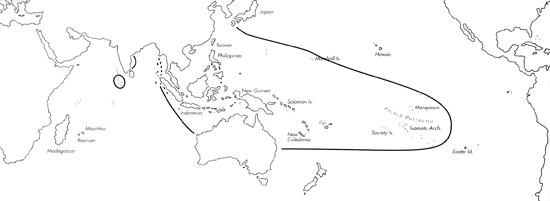Range: Central Indian Ocean (Maldives, S. India) to N. W. Australia to French Polynesia; Ryukyu Is. to Queenland; absent from Hawaii.
Description: Medium-sized to large, moderately solid to heavy. Last whorl conical to narrowly conical, outline straight except variably convex below shoulder. Shoulder angulate. Spire of low to moderate height; outline deeply concave, with a conoid apex of 6-10 postnuclear whorls projecting from an otherwise flat spire. Larval shell of 3.5-4 whorls, maximum diameter 0.7-0.8 mm. First 3-5 postnuclear whorls distinctly tuberculate; tuberculation disappears within adjacent 1-2.5 whorls. Teleoconch sutural ramps flat to variably concave, with obsolete spiral striae. Last whorl with fine variably spaced spiral ribs at base, obsolete in large specimens.
| Shell Morphometry | ||
|---|---|---|
| L | 50-104 mm | |
| RW | 0.10-1.25 g/mm | |
| (L 35-95 mm) | ||
| RD | 0.46-0.61 | |
| PMD | 0.85-0.95 | |
| RSH | 0.05-0.21 | |
Ground colour white, Indian Ocean specimens often variably suffused with orange to red. Last whorl with orangish brown to brownish black axial streaks, flames or zigzag markings from base to shoulder or shoulder ramp, varying from solid to highly divided. On each side of centre, a variably wide yellow, orange, brown or black, usually solid spiral band overlies the axial markings; colour of bands may vary from light to dark within the same specimen; abapical band occasionally, adapical band rarely divided into 2 or 3 narrower spiral bands. Intervening ground- colour bands usually interspersed with brown to black axial markings. Dotted and dashed or sometimes solid brown spiral lines extend from base to shoulder; they vary widely in number, occasionally containing intermittent white markings. Base violet to brown or black. Larval whorls pink. Early postnuclear sutural ramps immaculate; later ramps with orangish to blackish brown or black radial markings. Highly speckled shells intergrade with shells of largely uniform colouration; in W. Thailand, S. India, and the Maldives, uniformly coloured shells have an almost immaculate orangish to reddish tan last whorl and a very sparsely maculated spire (form krabiensis)(Pl. 33, Figs. 9, 10). Aperture white to bluish white, except for the base.
Periostracum yellowish brown to dark grey, thin to moderately thick, translucent to opaque, sometimes within the same specimen, and smooth or with fine axial ridges.
Foot yellowish grey; dorsum additionally washed with brown and dotted with white; marginal zones pale yellow; anterior part with a reddish brown median spot distally and brown dots in front of rostrum. Rostrum and tentacles yellow. Siphon pale yellowish grey, paler proximally, dotted with white and tipped with brown (Pl. 76, Fig. 49) (Chaberman, pers. comm., 1981).
Radular teeth with an adapical barb opposite a blade; pronounced serration on adapical half of the shaft; no basal spur (Kohn, unpubl. observ.).
Habitat and Habits: Intertidal to about 50 m, more common in subtidal habitats; in Philippines, dredged to 240 m (Guillot de Suduiraut, pers. comm., 1992); on coarse sand, muddy sand and coral rubble, often beneath dead coral. In W. Thailand, form krabiensis is reported from sand and rock bottoms in 12-30 m, in the Maldives from sand in 20-25 m. Similarly sized specimens of C. generalis have been observed in aggregations (Cernohorsky, 1964; Estival, 1981; Richer de Forges & Estival, 1986; Chaberman, pers. comm., 1981; Tirard, pers. comm., 1989).
Discussion: C. generalis resembles C. bayani, C. capreolus, C. monile, and most closely C. maldivus. In spite of similar shape and sculpture, C. capreolus is so dissimilar in colour pattern as to exclude any confusion. C. bayani has a less solid shell (maximum RW 0.3), fewer larval whorls but usually more tuberculate postnuclear whorls and a carinate shoulder; the spiral colour bands of its last whorl are generally narrower, less solid and lighter in colour and the basal parts are white. For comparison with C. maldivus and C. monile, see the Discussions of those species. The name C. krabiensis applies to small individuals whose shells are orange and almost immaculate (Pl. 33, Figs. 9, 10), and which range from the Maldives to W. Thailand and off N. W. Australia. However, they intergrade in size and colour pattern with typical C. generalis, and sometimes both types of pattern occur within a single specimen. Moreover, populations with small adults are also known from Sulu Sea, Molluccas, and E. New Britain. We therefore consider C. krabiensis a colour form of C. generalis. C. speculum (Pl. 33, Figs. 11, 12) was based on 2 juvenile specimens; Dautzenberg's varieties represent only colour forms: Var. regenfussi with narrow orange bands; var. subunicolor with broad brown bands, leaving a narrow white central band; var. pallidula with a pale colour.

C. generalis range map
This section contains verbatim reproductions of the accounts of 316 species of Conus from the Indo-Pacific region, from Manual of the Living Conidae, by Röckel, Korn and Kohn (1995). They are reproduced with the kind permission of the present publisher, Conchbooks.
All plates and figures referred to in the text are also in Röckel, Korn & Kohn, 1995. Manual of the Living Conidae Vol. 1: Indo-Pacific Region.
The range maps have been modified so that each species account has it own map, rather than one map that showed the ranges of several species in the original work. This was necessary because each species account is on a separate page on the website and not confined to the order of accounts in the book.